Memories of Yangchow

Some of you may know that during my youth, (2) I was interned by the Japanese in a civilian internment camp in China, together with my three brothers and my mother. I cannot condense nearly three years into this talk, but let me tell you some of the incidents and adventures that befell us during our incarceration there. By "us" I mean my brother Edgar and our friend Ian MacKinnon and me; one of which could have been positively dangerous, and others amusing.

First of all let me give you a brief history of Shanghai (3) where I was born, in order that you may more easily understand the situation. Shanghai then, was to all extents a foreign creation and not at all Chinese. Considerable urban development only became possible after the signing of the Treaty of Nanking in 1842 between Great Britain and China at the conclusion of the first Opium War. With that and subsequent agreements with USA and France, China agreed to open Shanghai and certain other ports to foreign commerce. Building upon these "unequal treaties" the foreign powers exerted little by little their immunities and privileges accorded to their merchants and captains of industry in the treaty ports. Parts of these cities were appropriated as concessions or colonies and ruled directly by the foreign powers. Each part had its own government and exercised their sovereign jurisdiction with their own police force and army. They could conduct business according to their own laws without interference from the Chinese authorities. From the signing of the final treaty in 1898 to the late 1930’s Shanghai grew to be the central clearing house for trade within the Yangtse river system and the rest of the world. It could accommodate within its 3.5 miles of warehouses 170 ships and 500 sea-going junks at the same time. Half of all China’s foreign trade was cleared through Shanghai. By the late 1930’s Shanghai had grown to be one of the urban wonders of the world and its waterfront the Bund world renowned. (4) With a population of more than 5 million, it was China’s most dynamic city, the 6th largest city in the world and a magnet for foreign investments particularly Britain’s.
 (3) Shanghai 1940
(3) Shanghai 1940 (4) The Bund looking North
(4) The Bund looking NorthLike Gaul, Shanghai was divided into three parts. The smallest part was the French Concession. (3) It was mainly a residential area abutting on to the river foreshore at its eastern end. Avenue Foche and avenue Edward VII marked its boundary with the International Settlement at its northern end. Its southern and western boundaries were with the Chinese Municipality of Greater Shanghai. In 1936 it had a population of half a million, of which a small fraction were foreigners, i.e. only 2,342 were French civilians, 2,468 were British residents and they were both outnumbered by 11,628 Russian residents, mainly white Russians, anti-Bolsheviks fleeing from the Soviet Union at the end of the Russian revolution. The remainder were Chinese, and Vietnamese etc. It was ruled as an almost absolute monarchy by the French Consul-General, assisted by a municipal council appointed by himself, but his relationship with them was akin to that of Louis XIV and the court of Versailles. For security the Consul-General could call on 4,000 gendarmes although only 300 were French officers in charge. The remainder of the force were Chinese and Vietnamese.

The heart of Shanghai was the International Settlement, (3) its commercial and industrial core counted hundreds of factories, miles of quays and warehouses, fashionable clubs and hotels and the consulates of the great powers as well as parks and pleasure-grounds where incidentally Chinese were not allowed. In fact Jessfield Park a favourite haunt of ours had a notice outside which stated "No dogs or Chinese allowed". Whether they could read the English text or not they were barred at the gate by a large Sikh policeman. The International Settlement formed a unique entity in the world of politics. Its area had a population of 1.2 million in 1936 but only 40,000 were foreigners; yet this minority ruled the settlement since its foundation but it did not belong to any one power. Its motto, "Omnia Junta In Uno". (5) ("All joined in one") was scrolled under a large "Y" whose arms were sub-divided into 12 flags of the nations concerned. I like to think that we had a United Nations long before it was ever thought of by the world leaders. The settlement’s constitution took its final form in 1898 and became known as the Land Regulations, although the issue of sovereignty was left unclear, its Municipal Council was really governed by British interests during most of its history. Until the early 1930s British and American Councillors were always a majority on the council.
The Germans had but one seat and even this was replaced by the Japanese after the 1st world war; the settlements political structure reflected the dominance of Britain’s supremacy in the city. 38% of all foreign holdings in China were British in 1931 and ¾ of that investment was in Shanghai. The British controlled more than half of all China’s shipping. The settlement’s police force, the Shanghai Municipal Police (SMP) had 5,000 members of police included Chinese, Sikh and later Japanese and Russian personnel but the commissioner and senior officers were always British. The ruling body the Shanghai Municipal Council, was limited from above by the "Consular Body" and from below by the "ratepayers". These were a small group of property owners mainly British and Americans (in later years also Japanese) dominated by the taipans, heads of the great British merchant houses and banks. The ratepayers met once a year to decide policy and to elect the council. A high property qualification restricted voting rights to a small minority of the European population. In 1935, only 3,852 out of the total 40,000 foreign residents had the right to vote and they effectively controlled the destiny of Shanghai. One could say that the International Settlement was an oriental echo of England before the Reform Act.
The largest, in both area and population was the Chinese Municipality of Greater Shanghai which formed part of the Republic of China under General Chiang Kai-shek, and constituted only the outer periphery of the city proper but had little effect on the two foreign enclaves within it. However, the dogs of war howled early through the Chinese landscape that summer of 1937 when in July the Japanese staged a provocative incident on the Marco Polo Bridge near Peking and used this pretext to launch a full scale invasion of China (6) (7) (8) (9) (10) (11). The Japanese push was severe and the Chinese forces were forced to withdraw from Peking. The following month Chiang Kai-shek launched a counter-offensive, moving three crack divisions to Shanghai and two days later 80,000 Chinese troops attacked the Japanese garrison of 5,000 troops at Hongkew. Outnumbered, the Japanese were nearly driven into the Whangpoo River but reinforcements in the nick of time under General Matsui Iwane landed 90,000 infantry and marines near the city. The Chinese forces were also reinforced and eventually numbered 300,000 troops. The Japanese, though inferior in manpower had superior tactics, training and equipment. The guns of the Japanese Third Fleet moored on the river Whangpoo pounded the Chinese held districts of the city. By the end of October the Chinese forces were massacred and estimates of 100,000 to 250,000 casualties were numbered. Whatever the exact number, the Chinese lost the cream of their officer corps; and their most effective fighting units were decimated. The Japanese lost about 40,000 men. The International Settlement remained relatively intact during the battle. One incident however, reached into the very heart of the settlement in a horrific way. On 7th August 1937 the Chinese tried to bomb the flagship of the Japanese China Fleet "Idzumo" moored on the Whangpoo opposite the Bund.
 (6) Marco Polo bridge plaque
(6) Marco Polo bridge plaque (7) Frank on Marco Polo bridge
(7) Frank on Marco Polo bridge (8) Marco Polo bridge side-profile
(8) Marco Polo bridge side-profile (9) Marco Polo bridge guardian
(9) Marco Polo bridge guardian (10) Marco Polo bridge statue
(10) Marco Polo bridge statue (11) Marco Polo bridge relief
(11) Marco Polo bridge reliefTwo bombs (12) exploded on Nanking Road (13), Shanghai’s most crowded street: shrapnel and flak smashed through the plate-glass frontage of Kelly & Walsh, a Publishing Company where my father was the manager, and other stores were equally damaged. Two other bombs fell on Avenue Edward VII, the boundary between the Settlement and the French Concession an estimate of 2,000 passers-by and shoppers were killed by the four bombs scattering bodies and limbs everywhere. Sufficient to say that from 1937 to the attack on Pearl Harbour on December 7th 1941 the Japanese grew more and more provocative in China taking most of the coastal towns and ports; thereby dominating the coast of China. Nevertheless in the interior of the country and in the countryside the Chinese were successful in adopting guerrilla tactics and harassing the Japanese so that China was never totally occupied by Japan. However both Chiang Kai-shek and the communists under Mao Tse- Tung were fighting on two fronts, fighting each other and defending themselves against the Japanese, not counting having to deal with different Warlords in certain areas as well. In late November 1937 Japan established a new government for the Chinese Municipality which was reorganised in April 1938 as the Special "Municipality of Shanghai". They now effectively controlled the areas that surrounded the International Settlement and by a mixture of guile and intimidation tried to extend their influence within the Settlement by first demanding more seats on the council in the hope of eventually taking it over. One of the major consequences was that thousands of refugees flooded into the settlement for protection causing rice riots as the price of rice went through the roof. In 1937 the Americans had a garrison of 150 officers and 2,600 men, the British had 90 officers and 2,500 men, the French had 50 officers and 2,000 men and the Italians had 20 officers and 750 men. By 1939 due to the events in Europe British troops were withdrawn back to their home base as they were needed there and The American 4th marines were pulled out a week before Pearl Harbour leaving the settlement unprotected as the French were now neutered and the Italians were on the side of the Axis. On December 8th 1941 the day after Pearl Harbour and having declared war on the Allies a Japanese destroyer steamed down the Whangpoo River before dawn and sank the British gunboat "HMS Peterel" (14) all hands were lost.
 (12) Chinese cartoon
(12) Chinese cartoon (13) Nanking Road
(13) Nanking Road (14) HMS Peterel
(14) HMS Peterel
Explosions, fire and palls of black smoke threw the Bund into panic; the destroyer proceeded downstream and captured the American gunboat the "USS Wake" (15). It had the distinction of being the only American naval vessel of WWII to be captured intact without a shot being fired and the Japanese flag was hoisted. It was later incorporated into the Japanese navy and renamed "Tatara Maru". The Japanese garrison of 8,000 men based in Hongkew marched into the settlement with little or no resistance. Many atrocities were committed by the Japanese thereafter, especially to the Chinese refugees as they were still flooding into the settlement, some of them trying to smuggle rice and if discovered were bayoneted on the spot. Pregnant women were particularly vulnerable if the guards thought they were smuggling under their clothes. They were bayoneted first and it was just too bad if they were wrong!! These are a brief summary of events leading to our internment in Yangchow.
Under the yoke of our Japanese rulers from 1941 to 1943 foreigners carried on in an uneasy existence in Shanghai, almost in limbo. Initially, daily life carried on as usual. We went to School (16) (17), played in the park, came home (18) had our meals and listened to the news on our radios. Just as an aside as my dad worked in a publishing establishment my older brothers were fed on all the latest comics such as the Gem, Magnet, Champion Hotspur etc, whilst us younger kids had the Beano, Dandy and Film Fun. We also enjoyed the annual of our particular comic each year at Christmas. Stealthily the Japanese exerted more and more pressure on the foreign community. They would have curfews at a whim and put up barbed-wire barricades between stretches of roads so that if you were caught outside one of these nuisances you would have to wait until it was disbanded. To us as children it was a great game as we got our roller skates on and were able to skate along the length of the empty, smooth tarmac roads, between barricades. In any case we could always evade the barricades where we lived by crossing over the road, climbing over the school gate, skirting the playground and coming out on the other side. Our school and the girls’ school next door were turned into "Assembly Centres" shortly before our own incarceration and were known as the YuYuen road camps. As boy scouts we use to collect paper and aluminium milk bottle tops for the war effort, and occasionally acted as messengers between the consulate and other locations. The next pin-prick we had to endure was compulsorily having to learn Japanese in school, but the teacher was such a mild mannered man that we ribbed him without mercy. When told to stand in Japanese we would sit and vice versa and then some would stand while others would sit and then we would change over causing total chaos in class. One of the worst offenders was a boy sat next to me and well known in England in later years as an actor and television star, Peter Wyngarde. Does anyone remember Department "S" and its hero Jason King? Well, that boy Cyril Goldberg was the very same person who changed his name when he became an actor in England and even in those bygone days was quite the exhibitionist. He was interned in Lunghwa Camp together with J.G.Ballard the author of "Empire of the Sun" which relates to a boy’s internment in camp. Incidentally the Headmaster of Cathedral School attended by that boy was interned with us and was the obvious choice to head the boy’s school in camp. The final insult we had to endure was the wearing of arm bands like the Jews in Germany perhaps that’s where they got the idea. All alien nationals had to wear a red armband (19) with capital "B" for British residents or a capital "A" for Americans and we each carried a unique number under the letter. Of course, rather than being humiliated we wore it with pride. Soon after they entered our homes and put stickers on all the expensive items such as furniture, bookcases etc, and anything they thought would be of use to them, "This is now Japanese property", however when they left we would peel the stickers off.





All British and American personnel were to be interned in "Civilian Assembly Centres", the Japanese euphemism for internment camps. People learned of their impending internment in February 1943, some tried to sell as many possessions as possible but the Japanese were eager to confiscate cameras, binoculars and radios etc. Most of us invested in camp chairs, folding stools and tables and as much tin food as we could muster. Pets had to go to the vets to be put down. Our internment came in early March, by which time all the internment camps in Shanghai were full up. We were told to assemble in the grounds of the Anglican Cathedral the Holy Trinity for shipment and internment in Civil Assembly "C" Yangchow.(20) We were instructed to take either a single bed or a camp bed each, together with bedding, mosquito nets, table ware and even sports equipment and a couple of trunks for clothing, books extra shoes boots, in fact everything you would expect to take on a long holiday only this was no holiday and would have to last us for the duration. All these items would be transported before us whilst we were allowed to take a hold-all or suitcase on the day of our departure. With hindsight I would imagine that the logistical problems would have been quite daunting. I don’t know who was in charge of the logistics whether the Japanese or our own consulate but whoever they were they did a splendid job. It’s not easy to ship over 1,200 people from Shanghai down the Yangtse River together with their precious belongings without things being looted, lost or appropriated and on the whole most arrived safely. The system used was highly efficient. Each one of us had an entrance number beginning with 10, 12, 14, or 16. This was followed by a slash and each individual of a family had a unique number which ran consecutively. Of course we were dispatched in groups of 200 or less at one time and I believe alphabetically so when we arrived there were many already there. There were three camps in Yangchow "A", "B" and "C". There were about 250 in Camp "A" 350 in Camp "B" and 600 in our Camp "C". However camps "A" and "B "were terminated and the inmates returned to Shanghai in September 1943 due to some American prisoners repatriated back to the U.S.A in exchange for Japanese prisoners there, leaving room to return camps "A" and "B" to other camps in Shanghai.
Internment.
When everyone had assembled at the Anglican Cathedral grounds and after a brief roll call to determine if we were indeed all present and correct, we were marched down Kiukiang Road to the Bund under the inquisitive stares of the ubiquitous Chinese and other onlookers. My younger brother tells me however that he and other youngsters rode on top of our bedding and other possessions conveyed by lorries to the steamer. We embarked on an overnight steamer which was to take us up river to the Grand Canal where we transferred onto barges to take us the rest of the journey along the Canal to our destination Yangchow some 150 miles north west of Shanghai. The journey by barge was to say the least uncomfortable. It took about five hours and as we were crammed together most of us had to stand, others fortunate enough could sit on their luggage, taking turns to stand to allow others to replace them. Of course there were no toilets, and as Fay Angus wrote in her book "The White Pagoda" - 'Men had the advantage of being able to relieve themselves over the rails of the barge while those around discreetly adverted their eyes. But sanitation for the women and children soon developed into a major problem, until someone emptied a small tin can of its precious contents. A circle formed facing out – that is with backs to the can and its occupant. Each time the can was used, the waste was emptied into the canal. It was the beginning of indignity, and my face flushed every time I heard the tinkling use of our self-styled rest room'.
Yangchow was a long established regional capital of China with walls surrounding the city like York or Chester but somewhat wider having outposts spaced along it and once had Marco Polo as its Governor, appointed by Kublai Khan. Our intended Internment Camp was an American Episcopal Mission School with its own surrounding walls about 3 metres high and beyond was the city walls itself thus offering an excellent location for the camp. It was but a short walk to the camp and after we arrived, we were "welcomed" or rather harangued by the camp Commandant Yamashita san while our camp representative Mr. Grant translated what was said. He told us that this was now our happy home and that we were brought here for our own protection and so long as we obeyed all the rules and regulations and orders of our Japanese guards, all would be well but if we tried to escape we would be shot!! A foretaste of what conditions would be like was when we dispersed and Ian MacKinnon who was one of the earlier arrivals brought us a glass of what was at first glance a glass of tea, but he said to me let it settle first before you drink it! It was water but full of muddy sediment. Families were allocated a small area within a room shared with others in House No. 4 (21) Our room contained my mother and 4 of us, 3 Molems, parents and a small son, 5 Tomlins parents, a daughter and son in their twenties and a younger brother Jimmy who was an excellent artist. 4 Tebutts, a mother, two grown daughters and a grown son, and finally Edith Kemp, Sonny Tebbutt’s girlfriend. So in total there were 18 of us in a room partitioned by curtains or sheets, whatever we could muster, with very little privacy culminating in petty problems being blown out of all proportions leading to stressful living conditions. The size of the room we all occupied was about 25 x 30 feet, which meant 40 square feet each or a space of 4 x 10ft, including access. The summers were extremely hot and humid and winters were harsh and intensely cold due to the fact that we were in a large land mass with the blast of Siberian winds blown from the north and of course the luxury of any sort of heating was unavailable. A few weeks later Sonny Tebbutt moved into the bachelors’ dormitory aptly named the Hornets’ Nest, for all the single men billeted in House No. 3. (22) The uninvited entered at their peril! An amusing incident worth mentioning – someone in the hornets’ nest placed an urinal on the floor and with a large jug of water poured the water into the urinal from a great height to make as much noise as possible and then with a shout kicked it over. The water ran over the floorboards and leeched down causing havoc amongst the shrieking woman’s dormitory below!

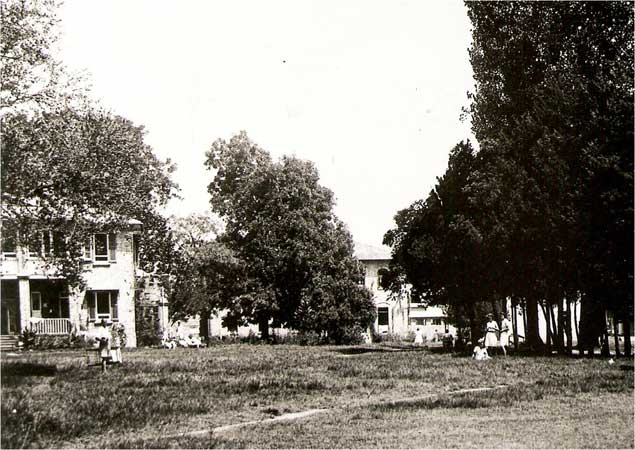
Roll call.
Dormitories had a Dormitory Monitor who was in charge to make sure we were all present and correct in the evenings. They were the ones that made sure the beddings and personnel effects initially went to the right families. They also acted as conduits to the camp committee for any complaints lodged. Roll Call in the early hours of the morning was a stressful occasion. We were often kept standing half an hour to an hour depending on the humour of the guards. In the summer it was often intensely hot and humid. Sometimes elderly people would faint from the heat. Initially we would number off in English but as the Japanese advance became more successful, over running Hong Kong and Singapore, they insisted that we would have to number off in Japanese. Many worried about not being able to learn the numbers quickly enough. Someone had the bright idea that if we stood in the same order each day we would only have to learn one number! A brilliant idea and it worked for a few days until somebody fell ill. When the guard came to the end of the row counting to himself his number did not agree with the last number called. Numbero, he shouted so off we went again Ichi, ni , san shi, go, etc, until he came across the culprit who had his face slapped hard. After that we had to learn the numbers off by heart. Roll call in the winter months were much worse due to the harsh and unremitting intense cold, especially the winter of 1944 when deep furrows were dug in the snow to allow us to stand in them, and by now many people were afflicted with severe chilblains as well because the shoes were now well worn out, and our diet was nothing to write home about causing many to be malnourished!!
Red & White Enamel Mugs & Plates.
Our Camp, the largest of the three, had three doctors and a number of nurses running a small hospital. When someone fell seriously ill in one of the other camps they would be brought to our hospita. Once a party of four internees from camp "B" carried a patient on a stretcher to our hospital. Ian, Edgar and I took the four to the dining room for a meal. They wondered why no one was using the enamel mugs and plates supplied by the International Red Cross. Apparently the Red Cross had sent them to every internee but we never got ours. The following day on the way to the "piggery" where Edgar helped Mr. Hay grow tomatoes, he looked inbetween the boarded up windows of the Jap stores and to his amazement saw the red and white plates and mugs stacked to the ceiling. The Japanese supply officer, called Tanaka san was noted for his greed and corruption, had obviously decided to keep them and probably sell them. When Edgar told us what he had seen we decided to break in and take what was rightfully ours. However should we have been caught our punishment would have been severe or worse! Early dawn, before assembly was the only time to do it. Problem one. How to meet up with Ian who shared a small dormitory room with the Goodmans, a family of four. Our first attempt had to be abandoned as Ian failed to wake up in time. How can we wake Ian up without disturbing the Goodmans? A brilliant idea occurred to us. There was a skylight above the door of their dormitory and Ian’s bed was next to the door. All Ian had to do was attach a piece of string to his big toe and pass the other end through the skylight. Again at dawn Edgar and I left our quarters, went to Ian’s block and tugged on the string and presto a sleepy Ian emerged. We went very quietly to the Jap stores and broke in. I climbed in through the window and passed out three plates and mugs to my brother whilst Ian stood look-out for any Jap guards. We were about to leave when I spotted a coil of galvanised wire which would be useful for tying plants etc, so I threaded one end through the keyhole while Edgar coiled it up at the other side of the door. Suddenly Ian hissed "someone is coming". Panic stations ensued; I was scrambling out of the window while Edgar was trying to break off the wire and run off with the wire plates and mugs. Phew!! It was only Mr. Crank on the way to feed the goats in his charge. Panic over; we all started to leave when Mr. Crank known as "Jumbo" for his immense size and physique insisted that I went back to get him a plate and mug also. Nobody argued with "Jumbo"!!
The Guards Initiated a Recount!!
Towards the beginning of September 1945 there were rumours that the War was over and everybody was frustrated at still being held in camp without any official confirmation. Ian, Edgar and I decided to scale the wall and have a wander around the city of Yangchow. This was not too difficult as the piggery used to stable the goats in one corner had the rest of the area devoted to growing tomatoes, cucumbers and corn. The man in charge Mr. Hay was a professional gardener, and with the help of Edgar and Nissim a Jewish youth, spent many backbreaking weeks removing all the stones and piling them up against the outer wall which offered an easy way to climb over the wall. We wandered along narrow streets and as we turned a corner heard English voices and was soon confronted by quite a large number of internees who had been allowed out with an agreement between Mr. Grant and the Commandant. Upon our return the Japanese guards counted three more than were let out. The whole camp had to assemble for roll call to satisfy the Japanese that all was correct.
Death by Hershey Bars.
Hershey bars in America are as popular as Mars bars here, but who wants to be bombarded by Hershey bars? VJDAY occurred on September 2nd 1945 when Japan surrendered after the atomic bombs were dropped on Hiroshima and Nagasaki. A few days later a Captain Cox (US army) and five other American officers arrived in a dozen rickshaws, one for each GI and the other for their equipment and personal effects. What joy and happiness we expressed especially when we saw the consternation and disgust felt by the Japanese when they had to surrender to these gum chewing and easy going Americans!! A hive of activity ensued thereafter setting up communications to contact the air force. By today’s standards it was a bit primitive, many young men and lads took turns to crank with both hands the handles of the magnetos to power the Morse code keys for sending messages. Two days later, to our relief and delight there was a parachute drop from a B17 bomber. The sky was filled with parachutes of all hues, descending down upon us carrying food, (PX rations) tins of peaches, cigarettes, medical supplies and Hershey bars. We saw the bomb bay door of the plane open and large palettes carrying 50 and 100 gallon drums filled with goodies drop from the sky whereupon the parachutes would open delivering much needed supplies. But the first drop was not entirely successful as many parcels fell outside the camp and some of us had to go abroad to retrieve them and as some Chinese houses were damaged as a result they had to be compensated by the Americans. We were then advised to paint a large .POW. on the roof of Block 3A which assured the next drop being more successful. However some parachutes didn’t open and drums broke on contact with the ground scattering goodies everywhere, much to the gratification of the youngsters picking up Hershey bars, scooping up peaches from smashed tins and ramming them down their throats. Another incident occurred when a parachute failed to open and a 100 gallon drum fell from the sky and scored a direct hit on the .(POW). going right through the roof of our building and narrowly missing two women who had rushed to the window to watch the excitement. Had one of them been in bed it would have been "Sayonara" for her without doubt!! The parachutes were very useful to the ladies as they made some colourful nylon dresses with them.
The End or Not.
I drew this sketch of the derelict guard house
(23). However the Jadivanese had
later restored it sometime in 1945
(24) (25) with machine gun turrets
deliberately pointing in our direction, as can be seen in this picture
of the charming ladies in front of our compound wall with the city
wall behind and the restored guard house on top. Quite a few adults in
camp were rather concerned but I believe and cannot recall that as
youngsters we never really felt threatened at anytime in camp. Whether
this may very well have been due to naivety or bravado I cannot say.
Nevertheless we can all be thankful that the Pacific War ended so
abruptly on September 2nd 1945. Later during the war crime trials in
Hong Kong evidence was revealed in document 2701 certified as Exhibit
"O" in Document No. 2687 from the International Prosecution Section:
British Division that the time and method of this disposition are as
follows:
-
The Time …individual disposition may be made in the following
circumstances:
- a. When an uprising of large numbers cannot be suppressed without the use of firearms.
- b. When escapes from the camp may turn into a hostile fighting force.
-
The Methods:
- a. Whether they are destroyed individually or in groups or however it is done, with mass bombing, poisonous smoke, poisons, drowning, decapitation or what, dispose of them as the situation dictates. In any case it is the aim not to allow the escape of a single one, to annihilate them all, and not leave any traces.
The following pictures depict work and camp life in general but interestingly (27) (28) indicate how we have aged between 1945 and our reunion in 1988 at Oaklands Park Hotel.
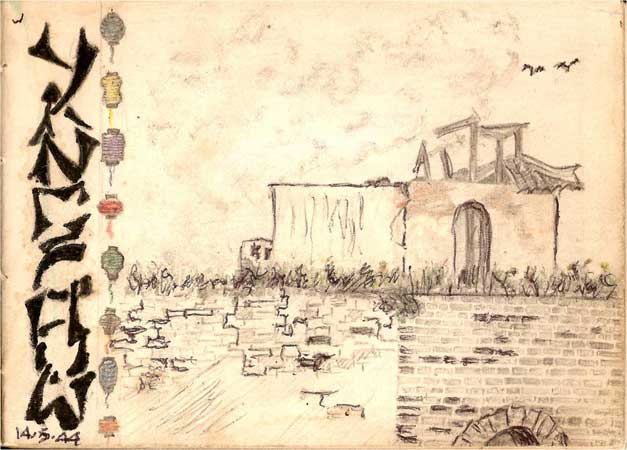


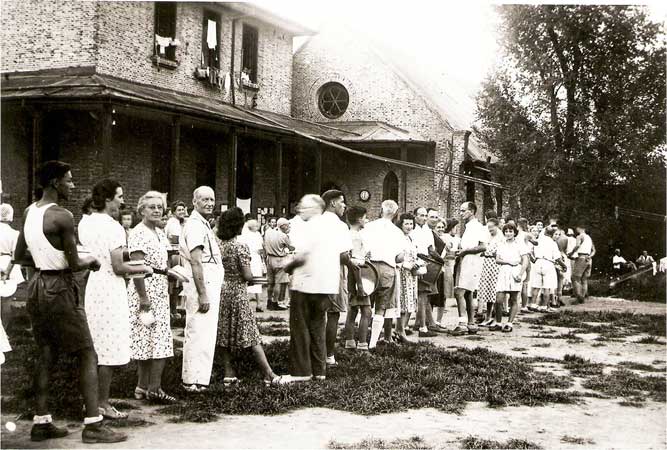 (26) Lunch queue
(26) Lunch queue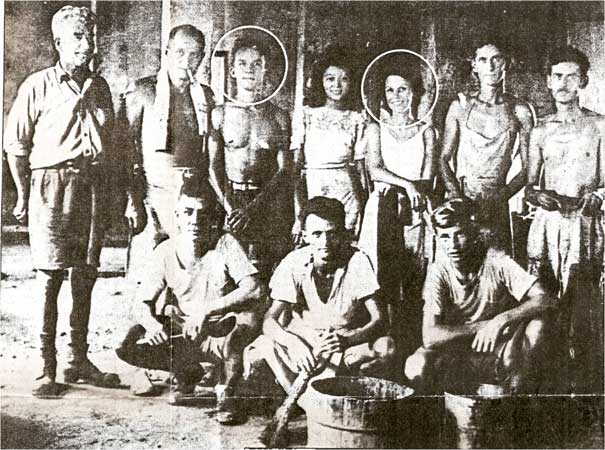 (27) Dusty Miller and the kitchen crew
(27) Dusty Miller and the kitchen crew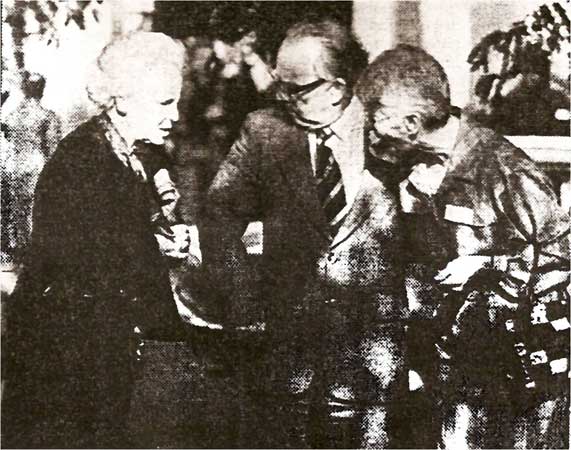 (28) As we that are left grow old
(28) As we that are left grow old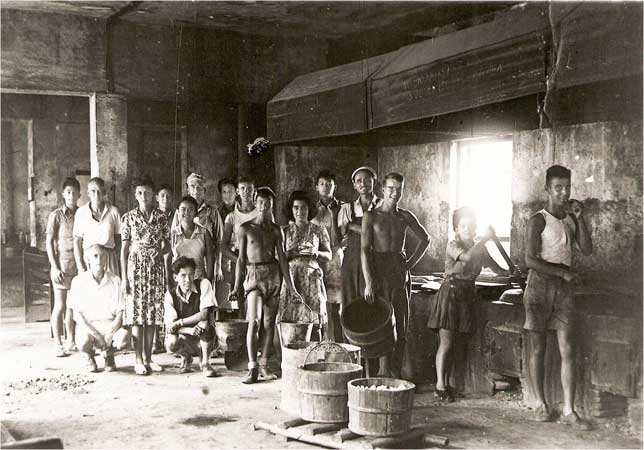 (29) Crew of cooks and stokers
(29) Crew of cooks and stokers (30) 'D' team outside the bakery
(30) 'D' team outside the bakery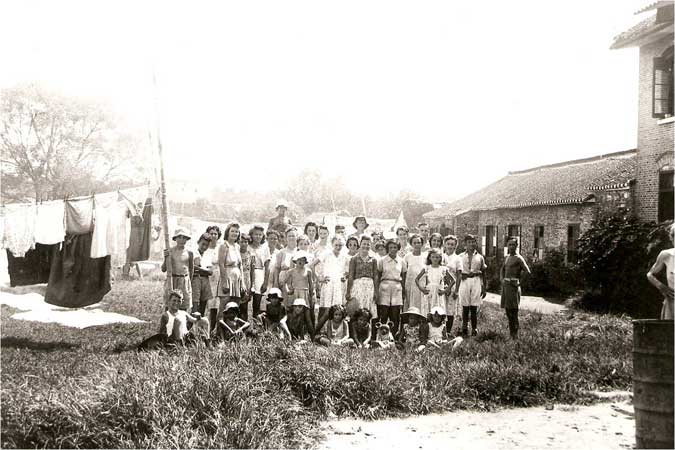 (31) Youngsters outside the laundry
(31) Youngsters outside the laundry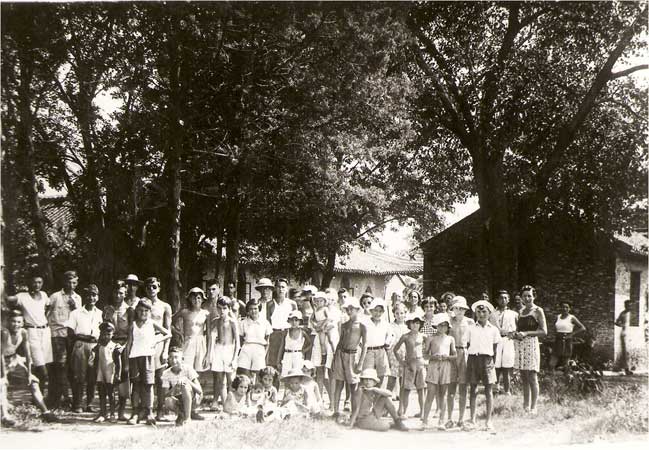 (32) Another group of kids
(32) Another group of kids